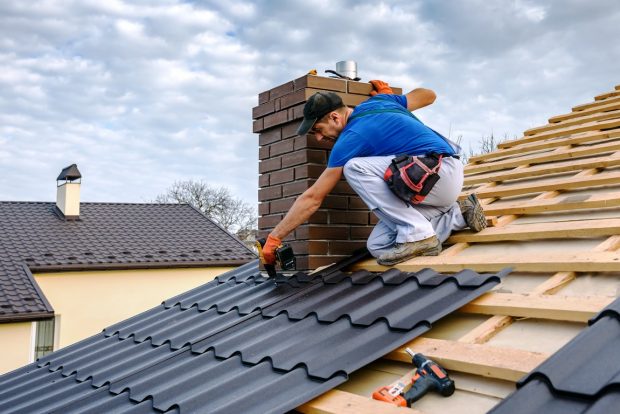Your roof’s problems could result in a lot of expensive repairs. Over time, it may need new shingles, roof mold removal, and possibly much more. You should get ahead of the problem rather than allowing such issues to accumulate. Waiting for a roof leak to occur is unnecessary. You may take immediate action before your roof leaks by being familiar with these signs of a damaged roof.

Old roof
The average roof can survive for 30 years. However, your location dramatically affects how long your roof will last. How is the weather, for instance? A lot of rain in your area may shorten your roof’s lifespan. It’s also important to consider the material of your roof. Depending on the type of shingles chosen, even the most common material, asphalt, differ in longevity.
The warning signals below may not always be obvious right immediately, alerting you to the need for a new roof. So you should stay informed on how old your roof is to stay ahead of the curve. Start by looking at your records. When was your roof put in place? What components were used? Since you moved in, has the roof been reshingled?
Consider calling a roof carpenter if it has been 20 years since your roof was inspected. They can inspect your roof and find any issues you might not have seen yourself. You can save money on otherwise expensive repairs by calling a professional before a significant leak happens!
Ceiling stains
A leaking roof is likely the source of any water stains covering ceilings or flowing down walls. Finding the leak is difficult, but fixing a roof leak is typically not too difficult. For the majority of the typical sorts of leaky roofs, there are some easy methods for locating and repairing them. Even if the leak isn’t bothering you much or you’re getting a new roof next year, you should still remedy the leak as soon as possible. Even over a short period, minor leaks can cause significant issues, including mold, rotten sheathing and frame, destroyed insulation, and damaged ceilings.
Damaged shingles
Broken shingles are unsightly and a potential source of leaks. However, the repair is simple if you locate the damaged shingles early enough. Are your shingles parallel to your roof’s surface? Whether they appear cracked, buckling, or damaged, they all indicate that you need a new roof.
Shingles that have been damaged don’t look good and might eventually produce a leak, which is more significant than cosmetics. To protect your interior from water damage, you’ll want to ensure your shingles are in the best condition possible.
Mold where a roof edge meets a sidewall
Kick-out flashing is essential where a roof edge meets the exterior wall. Without it, roof runoff may enter the wall and flow down it. The worst-case scenario is when water can leak beneath the trim and into a door or window below. Rot will eventually ruin sheathing and frame, even if you don’t detect it for years. In extreme situations, the wall’s support comes entirely from the stucco, which is quite dangerous. Avoid waiting for that to occur on your roof by addressing the problem early.
Corroded gutters
The first sign of a gutter leak is typically rusty material or a seam that has expanded or contracted and caused it to open up. The simplest solution to stop the leak is to cover the damaged area using roof and gutter repair tape if your gutter is still essentially sound (available at home centers and hardware stores). You can use wire brushes and putty knives to remove tar and corrosion. But calling a roofing expert is advisable to find out how extensive the damage is and address it.
A drooping roof
Sagging or drooping can be a sign that your roof needs repair. Check your roof for any drooping or sagging while you’re inspecting it. Also, look for rotting boards or any moisture that has been trapped. These warning signs that you require a new roof are no joke. Call someone as soon as possible to replace or fix the harm.
Damaged plumbing vent boots
Plumbing vent covers might be made of two pieces of metal, two pieces of plastic, or even entirely plastic. Check metal bases for cracked seams and plastic pipes for cracks, then look at the rubber boot covering the pipe. Water will enter the house along the line if that rots away or is torn.
If you have such issues, purchase a fresh vent boot to swap out the old one. The rubber-washer screws for metal roofing systems should be used to replace the nails at the base, even if the boot is in good condition and none are missing or have come loose.
Shiners
Check the inner side of the roof for “shiners” if you cannot spot any noticeable flow marks and the ceiling stain is relatively minor. A nail that didn’t reach the framing member is known as a shiner. Often, condensation forms on cold nails from moisture that has leaked into the attic from the rooms below.
When it’s cold outside, you might sometimes see this if you go up into your attic. Due to the frosted finish, the nails will seem white. The frost drips and melts when the attic gets warm throughout the day. Then, at night, the nails start to ice up once more. Use side-cutting pliers to snip the nail as a fix.
Loose step flashing
Walls that cross the roof are covered with step flashing, and each quick flashing part directs water over the shingle below it as it descends. However, water will flow directly behind the flashing and into the house if it rusts through or a piece falls loose.
Rusted chimney flashing
Brick chimneys can attract all kinds of terrible creatures. Galvanized steel flashing around chimneys is susceptible to rusting, especially if it curves 90 degrees at the bottom. Slipping new flashing under the old, corroded material is a simple but not exceptionally long-lasting solution.
The takeaway
Use these warning signs of a broken roof to safeguard your house.



